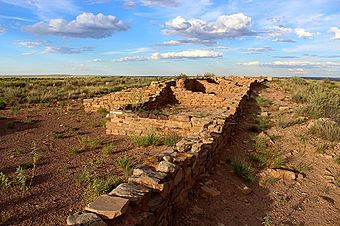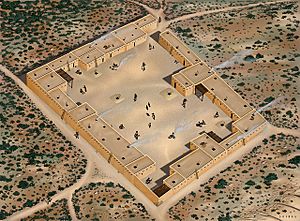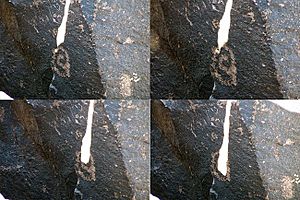Puerco Ruin and Petroglyphs facts for kids
Quick facts for kids |
|
|
Puerco Ruin and Petroglyphs
|
|

Late afternoon light on Puerco Pueblo ruins
|
|
| Location | Adamana, Arizona |
|---|---|
| Area | 9 acres (3.6 ha) |
| NRHP reference No. | 76000208 |
| Added to NRHP | July 12, 1976 |
The Puerco Ruin and Petroglyphs are the remains of a big ancient village, called a pueblo. This village was at its busiest around the year 1300 A.D. It had more than 100 rooms! It's the largest old site found in Petrified Forest National Park.
History of Puerco Pueblo
People lived here during two main times, each lasting about 100 years. The first time was from 1100 to 1200 A.D., and the second was from 1300 to 1400 A.D.
The Ancestral Puebloans, sometimes called the Anasazi, were the people who lived here. They used the flat land near the Puerco River to grow important crops. These crops included corn, beans, and squash. They were also skilled at making baskets and colorful pottery.
The Puerco River was like an ancient highway. It helped the pueblo trade goods and ideas with other groups. The people living here had connections with the Hopi people to the west. They also connected with the Mogollon people to the north.
The biggest period of people living here was in the 1300s. Many people moved from smaller places to larger pueblos like this one. This happened after a time of very dry weather. But by the late 1300s, the climate changed again. This made the people leave the area. The village was empty by 1380.
The site was first dug up by John Muir in 1905 and 1906. He was a famous naturalist.
What Puerco Pueblo Looked Like
The pueblo was built using sandstone blocks. These blocks were shaped by hand. The village was shaped like a rectangle. It had an open area, called a plaza, in the middle.
The buildings were one story tall. They had rooms used for living and for storing things. There were also special underground rooms called kivas. These kivas were used for ceremonies and important gatherings.
The outside walls of the pueblo had no windows or doors. People entered the village using ladders. They would climb over the walls to get inside.
Ancient Art and Tools at Puerco Ruin
The site has more than 800 petroglyphs. These are pictures carved into over 100 large rocks. One special petroglyph seems to show a journey. It might show the path from Puerco Pueblo to another site. That site is called Crack-in-the-Rock. It's now in Wupatki National Monument. This petroglyph is from around 1150 A.D.
Between 1988 and 1989, a team of archeologists worked here. They dug up parts of the site. They also recorded over 1,000 pieces of rock art. They found many items from daily life. These included over 4,000 pieces of broken pottery. They also found more than 26,000 stone tools.
These findings show that the people traded with others. They traded with settlements like Hopi, Homol'ovi, Flagstaff, Zuni, and Gallup. But many items were also made from materials found nearby.
One amazing petroglyph marks the summer equinox. For about two weeks around this time, the sun's rays and shadows create a special effect. They light up a circular design at sunrise.
The petroglyphs also show what animals were important to the people. While most animal remains found were small mammals like rabbits, the rock carvings are different. Bears are shown most often, making up 21% of the petroglyphs. Birds are also common, making up 16%.





